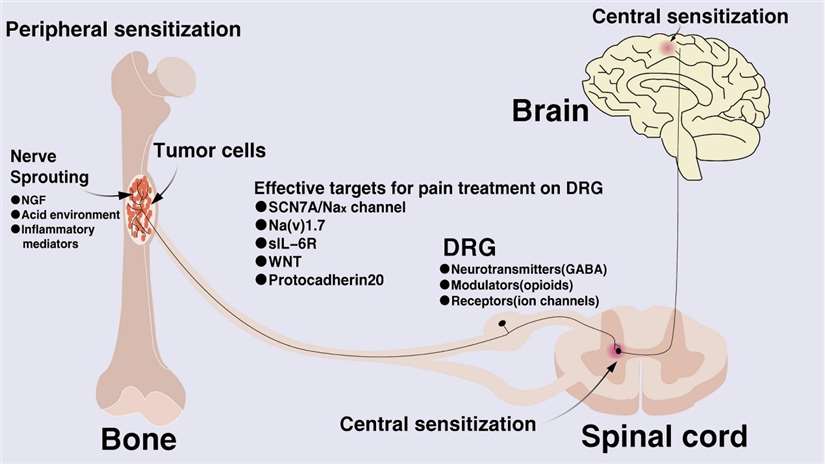- You are here: Home
- Disease Models
- Pain Models
- Cancer-Induced Bone Pain (CIBP) Model
Disease Models
- Oncology Models
-
Inflammation & Autoimmune Disease Models
- Rheumatoid Arthritis Models
- Glomerulonephritis Models
- Multiple Sclerosis (MS) Models
- Ocular Inflammation Models
- Sjögren's Syndrome Model
- LPS-induced Acute Lung Injury Model
- Peritonitis Models
- Passive Cutaneous Anaphylaxis Model
- Delayed-Type Hypersensitivity (DTH) Models
- Inflammatory Bowel Disease Models
- Systemic Lupus Erythematosus Animal Models
- Asthma Model
- Sepsis Model
- Psoriasis Model
- Atopic Dermatitis (AD) Model
- Scleroderma Model
- Gouty Arthritis Model
- Carrageenan-Induced Air Pouch Synovitis Model
- Carrageenan-Induced Paw Edema Model
- Experimental Autoimmune Myasthenia Gravis (EAMG) Model
-
Cardiovascular Disease Models
- Surgical Models
- Animal Models of Hypertension
- Venous Thrombosis Model
- Atherosclerosis model
- Cardiac Arrhythmia Model
- Hyperlipoidemia Model
- Doxorubicin-induced Heart Failure Model
- Isoproterenol-induced Heart Failure Model
- Arterial Thrombosis Model
- Pulmonary Arterial Hypertension (PAH) Models
- Heart Failure with Preserved Ejection Fraction (HFpEF) Model
-
Neurological Disease Models
- Alzheimer's Disease Modeling and Assays
- Seizure Models
- Parkinson's Disease Models
- Ischemic Stroke Models
- Acute Spinal Cord Injury (ASCI) Model
- Traumatic Brain Injury (TBI) Model
- Hypoxic-Ischemic Encephalopathy (HIE) Model
- Tourette Syndrome (TS) Model
- Amyotrophic Lateral Sclerosis (ALS) Model
- Huntington's Disease (HD) Model
- Intracerebral hemorrhage (ICH) Models
- Pain Models
- Metabolic Disease Models
- Liver Disease Models
- Rare Disease Models
- Respiratory Disease Models
- Digestive Disease Models
-
Urology Disease Models
- Cisplatin-induced Nephrotoxicity Model
- Unilateral Ureteral Obstruction Model
- 5/6 Nephrectomy Model
- Renal Ischemia-Reperfusion Injury (RIRI) Model
- Diabetic Nephropathy (DN) Models
- Passive Heymann Nephritis (PHN) Model
- Adenine-Induced Chronic Kidney Disease (CKD) Model
- Kidney Stone Model
- Doxorubicin-Induced Nephropathy Model
- Orthopedic Disease Models
- Ocular Disease Models
- Skin Disease Models
- Infectious Disease Models
Cancer-Induced Bone Pain (CIBP) Model
Creative Bioarray has been at the forefront of delivering flexible and cost-effective disease model services for several years. Our team of dedicated scientists has successfully developed a stable cancer-induced bone pain (CIBP) model, which has become an invaluable asset to our clients seeking to expedite their analgesic drug development processes. By leveraging our expertise and state-of-the-art facilities, our clients can gain deeper insights into the mechanisms of bone cancer pain and identify potential therapeutic targets, thereby streamlining their journey from preclinical research to clinical trials.
CIBP is a distressing condition characterized by the intense discomfort that arises when cancer cells metastasize to the bones or originate within the bone itself. This form of pain is often described as persistent, with sudden and spontaneous flare-ups, frequently accompanied by heightened sensitivity to pain, a condition known as hyperalgesia. The underlying mechanisms of CIBP are multifaceted, involving a complex interplay of factors associated with neuropathic, traumatic, and inflammatory pain. To study CIBP and develop effective treatments, researchers utilize animal models that replicate the human experience of bone pain due to cancer. These models are designed to mimic the pathophysiological processes observed in cancer patients, allowing for the investigation of pain mechanisms and the testing of potential analgesic agents.
 Fig. 1 Schematic diagram showing the mechanism of cancer-induced bone pain. (Zheng et al. 2022)
Fig. 1 Schematic diagram showing the mechanism of cancer-induced bone pain. (Zheng et al. 2022)
Our Cancer-Induced Bone Pain (CIBP) Model
- Available Animal
Mouse
- Modeling Method
Various tumor cells are cultured for implantation in the medullary space of the femur or tibia.
- Endpoints
- Behavioral tests: Von Frey test
- Body weight
- Histology analysis: H&E staining, IHC staining, etc
- Micro-CT
- Other customized endpoints
Example Data
 Fig. 2 The mechanical, heat, and cold allodynia enhanced after injecting Lewis lung cancer cells. (A) The mechanical allodynia was tested after CIBP surgery. (B) The heat allodynia was recorded after CIBP operation. (C) The cold allodynia was recorded after CIBP operation. (Ji et al. 2022)
Fig. 2 The mechanical, heat, and cold allodynia enhanced after injecting Lewis lung cancer cells. (A) The mechanical allodynia was tested after CIBP surgery. (B) The heat allodynia was recorded after CIBP operation. (C) The cold allodynia was recorded after CIBP operation. (Ji et al. 2022)
In addition, we also provide other pain models that maybe you are interested in:
- Migraine Model
- Neuropathic Pain Models
- Inflammatory Pain Models
- Visceral Pain Model
- Postoperative Pain Model
Quotation and Ordering
Creative Bioarray offers an extensive array of preclinical disease models designed to assist our clients in assessing the effectiveness of their drug candidates. Whether you are investigating a novel therapeutic agent or exploring the mechanisms of a disease, we have the expertise and resources to support your study, ensuring that the models used are relevant and the data obtained is reliable and actionable. If you are interested in our services, please feel free to contact us at any time or submit an inquiry to us directly.
References
- Zheng, X.Q., et al. Neurophysiological mechanisms of cancer-induced bone pain. Journal of Advanced Research, 2022, 35: 117-127.
- Ji, H., et al. A mouse model of cancer induced bone pain: from pain to movement. Frontiers in Behavioral Neuroscience, 2022, 16: 873750.
For research use only. Not for any other purpose.

